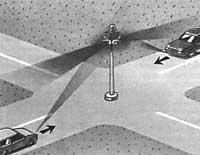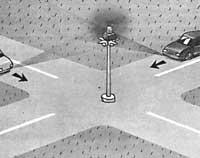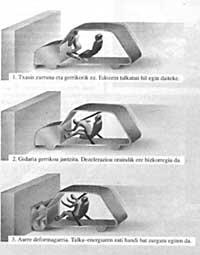Safety in cars
Accident data in France
How should children go in cars?
Statistics Statistics - Statistics

According to statistics made in France, the percentage of accidents in France has decreased since 1972. That year 16,600 died in road accidents and taking into account the number of vehicles there were, it must be said that the accident curve had skyrocketed. This curve has been rising from 1960 to the aforementioned year and has subsequently descended until 1985. This is due to the introduction of new rules in the code of circulation and the introduction of technical advances in vehicles: limitation of the maximum speed in many places, obligatory to place belt of safety, improvement of the roads, design of the chassis of the cars to withstand shocks, etc.
As a result, in France in 1988 there were 800 more “alone” deaths than in 1960. In 1988 there were four times more cars.
Unfortunately, the percentage curve of deaths since 1985 is not decreasing and, if nothing is done, there is a risk that the traffic index, which is the number of vehicles multiplied by the number of kilometers traveled, will increase with the traffic index.
Improvements in cars
Motorists try to protect people from the interior during the car crash. For this purpose, seats have been fixed, good seatbelts have been placed, they have been arranged in the form of mattress inside, the front of the chassis has been designed as impact shock absorber, etc. They perform them. According to experts, all of them are measures to improve passive safety, that is, measures to alleviate the effects of the shock. The active safety measures are those that are adopted to avoid the accident.
Frontal collisions
As for passive safety, it should be noted that 60% of all road accidents in which dead or injured are found occur by a frontal collision of the car. For this reason, car manufacturers currently design the chassis and body in such a way that they slowly deform in the collision at the front. With a wall facing a speed of 57 km/h, the energy of the accident is absorbed until it compresses and deforms the front and the part of which they travel remains intact. To know the scope of the collision, it should be taken into account that the car is like hitting the ground dropping the fifth floor of a building.
Since almost all frontal shocks (95%) occur at speeds below 57 km/h, the deformable chassis solution is very suitable. However, this system is not enough to protect itself from a faster collision. To absorb shock energy at 100 km/h, for example, the front of the chassis (from the steering wheel) should have a length of 2.60 meters.
Although the impact occurs at a speed of 57 km/h, in addition to the deformable chassis, seat belts are needed to prevent passengers from leaving the seats. It is advisable to wear belts dressed in front and rear seats and not only front seats, as according to experts it would be 29% less dead in accidents. We must also change the tendency to not dress with certain trips to the belt. In surveys conducted, one in four does not hold belts when travelling by car.
Another problem of belts is stretching when it is brake sharply or at the same time as it collides. Thus, the traveler does not become a projectile that hits the previous glass. In a system developed by the Honda house, by means of the pyrotechnic firing of a decimselerometer, the belt is automatically dyed in hundredths of a second.
In the field of passive safety, European cars will resemble in the coming years those of America with a padding or inflatable balloon in the steering wheel. The blow of the pad is sent by a deceleration caper when it is brake sharply. On the steering wheel is inflated in a second and ready to cushion the blow. In the United States, motorists have the opportunity to place belts or inflatable cushion. In Europe, however, the belt is obligatory and they also think to put cushion in the steering wheel.
Cross-sectional collisions
For the inflatable cushion to be really effective, the shock must be front. However, as has been verified in the surveys, in 80% of the accidents considered as preliminary, the shocks are actually somewhat crossed. If the traveler moves as a projectile to the left or to the right, the inflatable pad of the steering wheel will not fulfill its function. For this reason, engineers study the placement of these cushions on the side doors.
Considering that 17% of traffic accidents are indirect mattresses, these mattresses of the doors would be an adequate protection. But working properly is very difficult. Note that the door has little thickness and has no engines, capots, etc. as in the frontal collision. Therefore, the door cushion should be inflated in 15 milliseconds (three times faster than the steering wheel cushion). On the other hand, it is difficult to decide where to place and of what type the captor that orders to inflate. The sensor must be ultrasensible but it works only in case of real shock.
Volvo proposes a set of measures to reduce damage to indirect collisions, its “Side Impact Protection System”. In addition to the inflatable pads of the doors, it proposes the filling with flexible material of the sheets of doors, the consolidation of the vertical fixed piece between the front and rear doors and the implementation of a damping structure under the two rigid bars that are transverse under the seat and the transmission tunnel. The objective is to absorb energy in the transversal collision. In tests at 55 km/h, Volvo has managed to reduce the vertical column between doors by 10 centimeters.
Prevention of accidents or active safety
The above has consisted of passive safety measures taken to protect passengers in the event of a collision. In principle, however, it is much better to avoid collisions or accidents. In this regard, active safety measures are included to avoid accidents. According to the experts of Renault and Peugeot, the number of very serious accidents can be reduced by half or even by a quarter, deepening the path of active safety. The first steps are braking systems, suspension and improvement of the behaviour of the car.

In recent years the ABS system has been extensively extended which prevents the total lock of the wheels in the braking. Through this system, the driver can govern the direction of the car by braking sharply on the road. To detect the rotation speed of each wheel there are several sensors whose signals are collected by a calculator. When a wheel drops too fast and will block it, by means of super-fast valves (responding to 3-7 milliseconds) reduce the brake pressure. When the wheel is glued to the ground, the brake pressure increases. This cycle is repeated until the car stops.
Another important point is the improvement of lighting. The Volvo house has begun to use ultraviolet light lamps. The light of these lamps during the night does not dazzle the driver who comes in the opposite direction so they can be used as short light. The ultraviolet lights are short wavelength and are usually not visible to the naked eye. However, if they reflect fluorescent materials, the wavelength increases and can be seen normally.
With the installation of a powerful UV light source to the car, the fluorescent signals of the road allow the driver to see up to two hundred meters at night and not up to 80 meters, as with current conventional short lights.
Another system that European motorists are studying is that of infrared rays. These rays are not seen at first sight either. The car's infrared lamp would emit the following rays and a camera in the same car would detect that light and send the signals to the poststeering screen, where the driver would see the road far and clearly.
Programa Prometheus

The active safety measures that have been developed during this decade are the so-called “assisted driving systems”. Once the car automatically detects the obstacle, the speed of the vehicle changes, always keeping the minimum safety distance. For the development of these systems in Europe there is a program “Prometheus” (Program for an European Traffic with 118efficiency and unprecedented safety) that will allow to standardize interactive signaling on roads.
One of the branches of the Prometheus program is expected to double the road signs, emitting a constant feature next to the normal signal and placing another with “intelligence”. At the end before the motor of the car there would be an infrared camera and studying the wavelength of the beam emitted by the “smart” signal, the signal (stopa, overtaking prohibition, speed limitation, etc.) the vehicle would recognize it automatically and in the driver panel would appear the symbol.
These “smart” emitters, which would take advantage of solar energy, would run by battery, but their cost for the moment is twice that of the conventional signal, 30,000 ptas. environment. In any case, these special signals can be placed little by little on the roads providing first “black spots”. The collection and treatment systems of this information in cars are expected to begin to be implemented within 5 years. The buyer may purchase a vehicle that has or does not have this equipment. The cost of the equipment would be about 150,000 pesetas.
In the long term, motorists want to put more sophisticated systems in their vehicles. In the front they will have laser telemetry equipment and, once reflected and collected the laser beams, the car calculator discovers whether the obstacle is fixed or mobile. If it is a mobile obstacle (another car), calculate the safety distance of the car. In it it is checked whether the road is wet or not with a humidity collector. If that security distance is not maintained, it can automatically affect the vehicle's brake. However, if you have to get ahead of the one in front, the automatic braking system would no longer turn on the flashing light.
However, the Prometheus program is another aspect that will significantly reduce the number of fatalities in accidents, which is known as “cooperative management” of layoffs. A third of traffic accidents occur on the trails and expect that with this system there will be 16% less.
The infrastructure for obtaining these “smart” tolls is the one that requires more dedication. In the car you only have to place in front of an infrared light emitter. At the center of the crossing will be placed an “atmosphere” that can receive infrared lights from all directions.

The girofaro faces three typical cases: 1) If the car is only within a given perimeter, there is no danger and the setting will appear in green. 2) If two vehicles are opposed, the setting gets red. 3) When two vehicles circulate in the opposite direction by the same way, the work of the girofaro is more complex. If two vehicles cross straight or both are directed to the right, there is no danger and the setting remains green. If the two cars go to the left, there is risk of accident and the girofaro appears red. The Girofaro can know what each driver wants to do when firing, because the flashing light changes the infrared rays of the transmitter.
The European program Prometheus also contemplates the development of a system to prevent the driver from sleeping on the highways and the preparation of other systems in the hope that the dead in road accidents fall in half.
In 1986 they died 5.5 per 100 accidents, 5.6 in 1987, 6.2 in 1988 and 6.2 in the first quarter of 1990. In the same quadrimestre there were 10 deaths per 100 motorway accidents, 9.9 on main roads, 9.3 in the department and 2.3 on narrow roads of villages. However, the highway is the safest place, since of 51,362 accidents only 1,914 have occurred in it, 9,892 on main roads, 15,802 in the department and 23.754 in the municipalities. The total number of accidents occurred in the quadrimestre were 3,177: 474 pedestrians, 86 cyclists, 187 mopeds, 213 motorists, 2047 motorists and 170 truckers. From August 1989 to July 1990, the number of accidents (167.190) was 1.8% lower than the previous year and the number of injured (231.438). However, the number of deaths (10,641) is 4.2% higher than the previous year. |
The physical characteristics of children are uneven, which creates barriers. Up to 14 years the height of the child increases from 1 to 3 years and its weight from 1 to 18 years. The proportion of extremities also varies. The infant's head is 1/4 of the body and 1/8 of the adult, the legs of the child 3/8 and the legs of the adult 1/2. Taking into account the change in body size, each age has its proper posture.
1. For infants (6-9 months) cribs are placed with a safety belt and the child is tied with a belt or a net in front.
1. Infants. Seat cot, which gives way to a child.2. The first seat of three and four years is different. It has lateral defenses and is well tied with straps.
2. Young children. Special seat well tied.3. Boys and girls 4 to 12 years old can use the normal belt, but to lift the body a calcareous pad is placed under the ass. If not, during the shock the body tends to go under and the bones of the legs to put in the belly.
3. Children. Case and belt.
According to experts, if the children were well tied in the cars, only in France there would be 80 dead less per year (now 200) and 500 wounded less (now 1,100).









